Introduction
In this Arcteryx Nuclei FL Jacket Review, we highly recommend the Nuclei FL for wet weather backpacking and overnight alpine rock climbing when there’s a good chance the jacket will accidentally or unavoidably get wet.
This was our highest rated lightweight windproof synthetic insulated jacket in our Spring 2016 comparative tests. However, Arcteryx discontinued the Nuclei FL in 2017 and several other manufacturers have since released superior products. We left our original review unchanged below in case you find this jacket on sale.
This Arc’teryx Nuclei FL Jacket review features the best lightweight synthetic insulated jacket we’ve tested. It weighs a mere 9.9 oz. (281g) in men’s medium, packs down to the size of an orange, and has a suite of refined features that make it our top choice for backpacking and three-season climbing. It also works well as a mid layer in frigid temperatures. We much prefer the Nuclei FL to the Rab Xenon X, the longstanding champion in this class, because it’s 20% lighter, similarly warm, has an adjustable hood that’s more comfortable for use with and without a helmet, has higher handwarmer pockets that lie above a hipbelt, and the waist drawcord tucks up and away from a harness. The Nuclei FL is a shining example of minimalist design. It wins our highest recommendation for an all-purpose lightweight synthetic insulated jacket.
Features
- Highest warmth to weight ratio of all lightweight jackets tested
- Packs to size of an orange
- Doubles as a mid-layer in frigid temperatures
- Adjustable hood is comfortable with and without a helmet
- Handwarmer pockets lie above the hipbelt
Performance Evaluation for the Arcteryx Nuclei FL Jacket Review
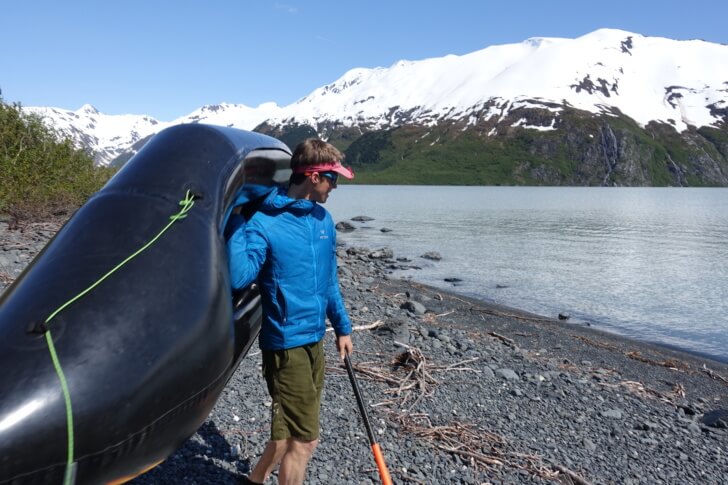

Warmth
The Nuclei FL has 2.82 oz.(80g) of Coreloft insulation in the body and 2.12 oz.(60g) in the side panels and sleeves. Most lightweight jackets, including the Xenon, use 60g insulation throughout. Though this might lead one to believe the Nuclei is wholly warmer than 60g jackets, we found the Xenon’s arms to be slightly warmer than the Nuclei’s. Overall, we rate these jackets equivalent in warmth.
Unfortunately, the industry lacks a standardized method for measuring CLO values and some manufacturers don’t release their internal test results. Thus, unlike down, we don’t have reliable lab data to evaluate insulation performance. In our field tests, we found Coreloft to be slightly less warm for its weight compared to Primaloft Gold. Perhaps by 10%?

Weather Resistance
The Nuclei FL’s fabric does not have a water resistant PU coating or membrane such as Gore Windstopper. As with all similar fabrics, water saturates it quickly once the DWR coating wears off. Unlike highly breathable synthetic insulated jackets, the Nuclei FL’s fabrics are windproof. Thus, the jacket is great for stop-and-go activities like hiking and climbing, where you carry a waterproof shell that can go over the jacket if necessary.
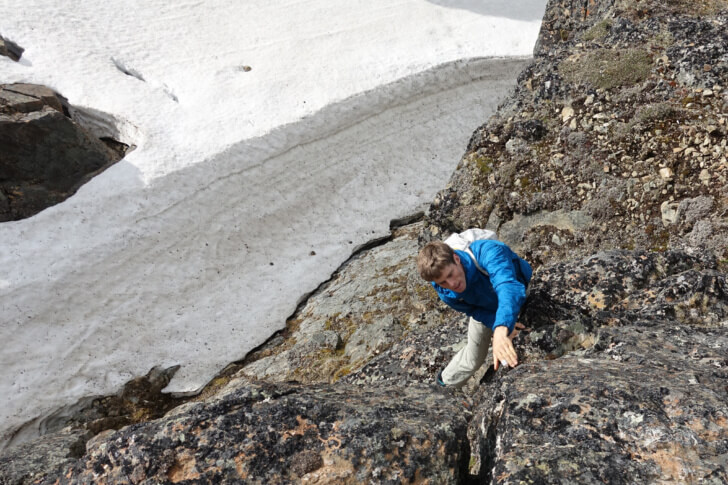
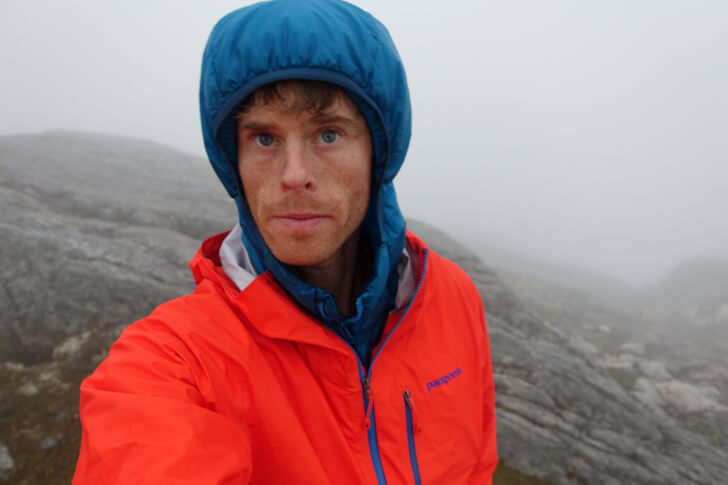
Breathability
The Nuclei FL is only breathable enough for use as an active mid layer if it’s very cold. For example, Mark and Janelle Smiley used it as an outer layer and under a hardshell for their successful third attempt of Denali’s Cassin Ridge.
Mark speaks highly of the Nuclei FL: “We were sponsored by Rab in 2012 and the Xenon was my favorite piece of theirs. The Nuclei is so much better. It’s the piece I have on or in the pack year round.”
Janelle says, “It is perfect, I don’t own fleece anymore because of its warmth and versatility. I have not worn it while ski touring in the Tetons, just at breaks or on the descent, or when a storm rolls in. I did wear it a bunch on the Cassin and on Middle Triple, and almost the whole climb of the North Face of Edith Cavell in October, so it works great in cold climates.”
The Smiley’s experience also supports our finding that the Nuclei FL is best for active use in cold weather. In most cases, and with most bodies, active insulation jackets like the Patagonia Nano Air Hoody and Arc’teryx Proton LT Hoody perform better in winter and are more versatile as midlayers. Ultimately, it comes down to how much heat you generate (some people are a lot sweatier than others) and what you’re doing (walking fast on a trail generates less heat than climbing a vertical face).
Durability
Fabric
This jacket uses an ultralight 10D fabric that is not as tough as the Rab Xenon X’s 20D fabric. This is a good thing. We strongly believe that a very light fabric is the best type for the amount of insulation in a lightweight jacket like this. Here’s why: In testing other similar jackets for the long-term, primarily the original Rab Xenon (10D Pertex Quantum GL fabric), we found that the insulation wore out faster than the fabric. If the Nuclei FL’s fabric tears, wipe the area with alcohol and stick on some Tyvek tape. No big deal.
Insulation
We don’t know if the Nuclei’s Coreloft is more durable than Primaloft Gold. Thicker fibers usually last longer than superfine fibers. Coreloft combines 1 and 3 denier fibers and Primaloft Gold might combine 0.5 denier and 4 denier fibers. (Primaloft won’t disclose the exact fiber size. They say their fibers are typically about 98% smaller than the diameter of a human hair.) The reality is that all highly compressible short staple synthetic insulations breakdown quickly. Try to use a synthetic insulated jacket only when you actually need their moisture management properties.
A continuous filament insulation would be more durable than Coreloft. Unfortunately, at the time of writing, we don’t know of any lightweight windproof jackets with continuous filament insulation. Both ZPacks and As Tucas say they intend to make one in the future.

Comfort
The Nuclei FL has a trim, athletic cut. The same size Rab Xenon X is boxy and bulky and is a better choice for wearing lots of layers underneath or perhaps for people with stockier builds (you could also size up with the Nuclei FL).
Arc’teryx did a fantastic job with the Nuclei FL’s features. In comparison to the Rab Xenon, the hood (adjustable with one cinch at the rear) is far more comfortable with or without a helmet, the handwarmer pockets are set above a pack’s hipbelt instead of low by the waist, the waist drawcord stows inside the jacket so you don’t accidentally clip it when climbing with a harness (instead of the Xenon’s two easily clippable drawcord loops). Though these are minor features, they add up to a significantly more comfortable jacket. The Xenon’s only comfort advantage is its exterior chest pocket, which we very much appreciate, but would not trade for the Nuclei’s features.
Weight and Compressibility
The Nuclei FL is the lightest and most compact synthetic insulated jacket we tested. It weighs 9.9 oz. on our scale. This is extremely light–20% lighter than the Rab Xenon and LLBean Primaloft Packaway.
The Nuclei FL stuffs into an included sack with a clippable loop. We prefer this to the pocket-turn-stuff sack that the Xenon and many other jackets use because the dedicated stuff sack is much smaller and takes up less room on your harness. We’ve also found that, unless you’re always patient and careful, the zippers on pocket stuff sacks can catch and tear fabrics.
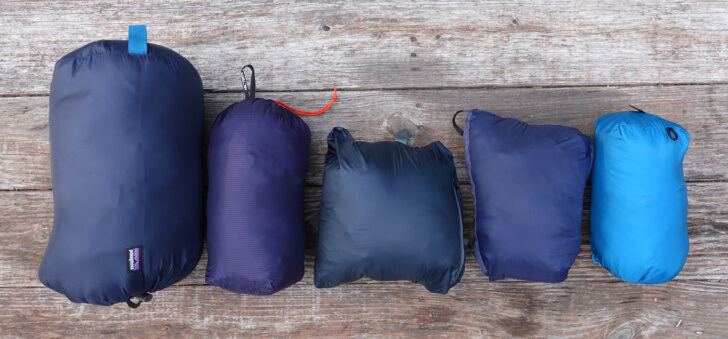
Value
At $239 retail, this is a good value if you do a lot of wet weather backpacking or overnight alpine rock climbing and highly value the 2.4 oz. weight savings compared to its closest competitors.
The $159, 12.3 oz., LLBean Primaloft Packaway Hooded Jacket is the best value lightweight synthetic insulated jacket we know of.
We’d be remiss to not mention that down jackets are a vastly superior long-term value because they’re warmer for their weight and are many times more durable.
Performance Highlights
Hiking: This is our favorite synthetic insulated jacket for mild to moderately wet backpacking in warmer temperatures, where we occasionally wear it under a rain jacket. For soaking wet and colder (less than 50F) conditions, a high-loft hooded fleece performs better because it’s warmer when wet, more breathable, more comfortable when soaked, and dries faster.
Climbing: The Nuclei FL excels at warmer weather alpine and big wall rock climbing when there’s a decent chance of precipitation or when precipitation would force you to bail if a down jacket got wet.
Aerobic activities: This jacket and those similar to it are a poor choice for most highly active pursuits because the fabrics are insufficiently breathable. Windproof jackets work well when you’re moving, and it’s frigid. Some people that don’t sweat much can wear them when charging hard. But not many. Max soaked the jacket with sweat when ski touring. Luc found it far too warm. Fleece and active insulation jackets are ideal for use as a mid-layer for aerobic pursuits in cold conditions.
Summary: Arcteryx Nuclei FL Jacket Review
Strengths
- Highest warmth to weight ratio of all lightweight synthetic insulated jackets
- Most versatile type of synthetic insulated jacket
Limitations
- Active insulated jackets are more breathable and perform better as mid layers in winter
- The short staple insulation is relatively fragile. However, we don’t know any company that makes a similar jacket with continuous filament insulation. We expect Arcteryx to update the Nuclei FL with their Coreloft Continuous in the next year or two, which will increase durability.
Recommended Uses
- All types of multi-day three-season trips
- As a mid layer in frigid temperatures (but active insulation jackets generally perform better in winter)
Market Comparison
A comprehensive Synthetic Insulated Jacket State of the Market Report will be released on March 25, 2018. When that report is published, we’ll update this review with a comparison summary of this product with other notable products in the review.
Related Content
This review is part of a comprehensive State of the Market survey of synthetic insulated jackets that has been ongoing for the past two years. Included in this survey:
- Arc’teryx Kappa Hoody Review
- Patagonia Nano Air Hoody Review
- Outdoor Research Uberlayer Review
- Rab Xenon X Review
- Montbell Thermawrap Guide Review
- Rab Nimbus Review
- Patagonia Nano Air Light Review
- LLBean Primaloft Packaway Review
- Arc’teryx Proton LT Review
- Black Diamond Heat Treat Hoody Review
- Patagonia Micro Puff Hoody Review
- Arc’teryx Nuclei FL Jacket Review
- Nunatak Skaha Apex Review
- Montane Spitfire Parka Review
- Arc’teryx Nuclei AR Parka Review
- Patagonia DAS Parka Review
- Synthetic Insulated Jackets State of the Market Report (TBA March 25)
Disclosure
The manufacturer provided a sample of this product to the author with no agreement, requirement, or obligation for media coverage of any kind. Some links are affiliate links, which means if you click through and make a purchase, Backpacking Light gets a small commission on the sale. This comes at no extra cost to you and helps support Backpacking Light’s efforts to publish authoritative and valuable information about lightweight backpacking gear and techniques, inspiring stories and film festivals, and remain an active member of the outdoor industry to promote and protect opportunities for public outdoor recreation.






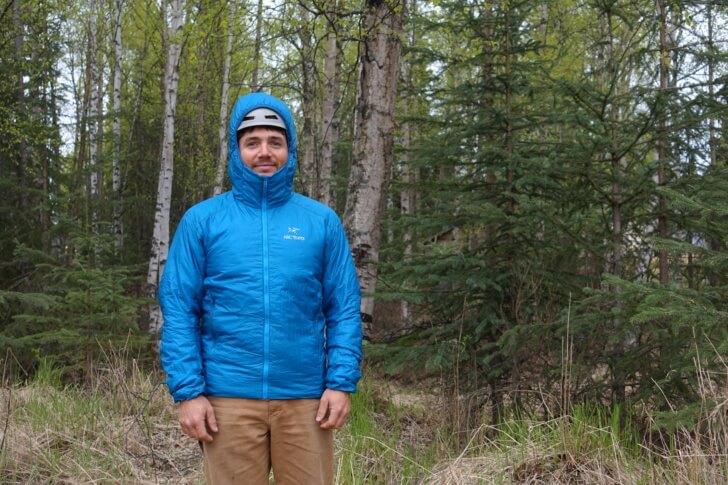



Home › Forums › Arcteryx Nuclei FL Jacket Review